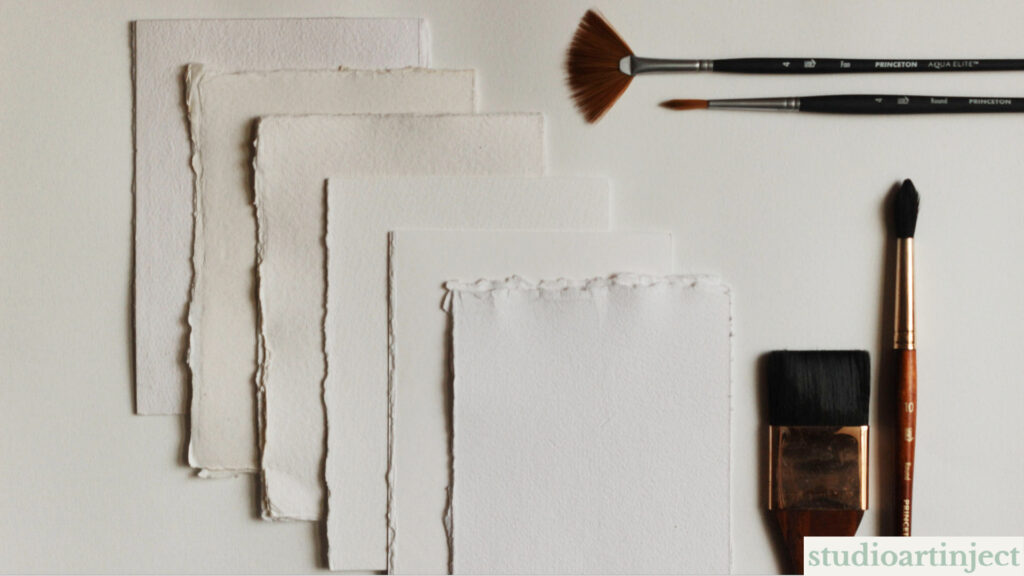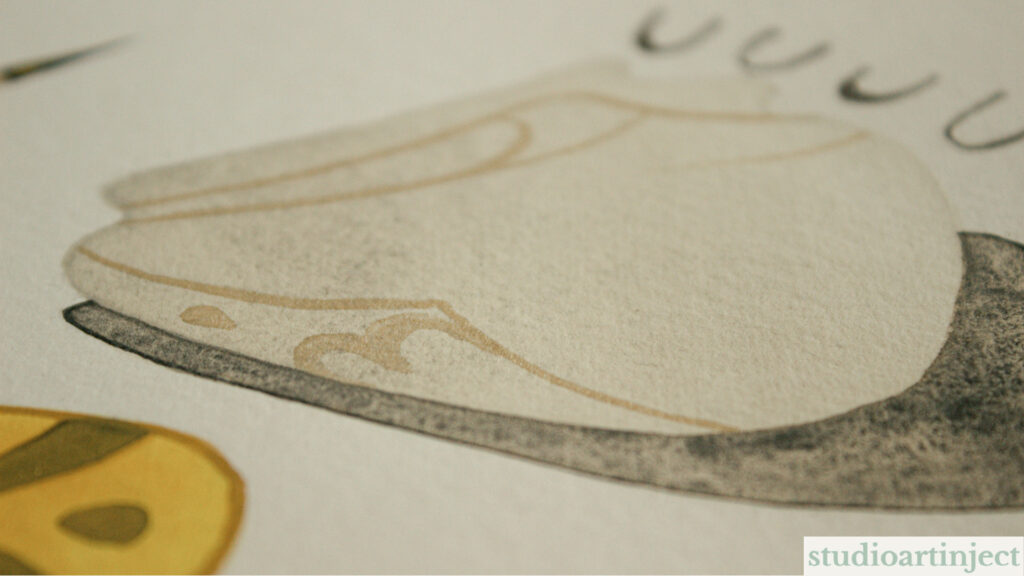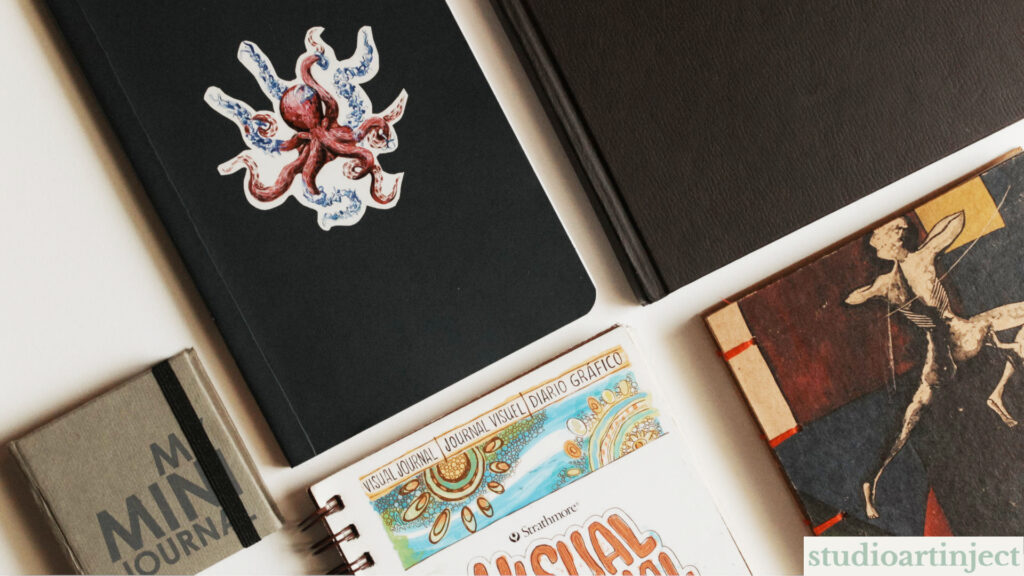In this blog post, I want to familiarize you with the different types of art papers available for drawing, watercolour painting, and mixed-media art. By the end, you should gain some clarity around the question, “What paper should I use for my art?”

Characteristics of Paper
A paper varies primarily based on the thickness of the paper, the composition of the paper, and the texture of the paper. And it is on the basis of these three qualities that the use or purpose of the paper is decided.
Thickness or Weight of Paper; What is GSM of Paper?
The weight of paper, which often also dictates its thickness, is generally measured using the unit- grams per square meter (gsm) or pounds (lbs). Higher the gsm/ lbs, thicker the paper, and more layers of paint can it handle.
Composition of Paper
Paper is made of pulp, which contains cellulose fibres, which may either be natural or man-made. Traditionally, the most widely used cellulose fibre is obtained from trees in the form of wood pulp.
Art paper is often made of cotton rag or plant fibre such as rice and hemp. Cellulose from materials like cotton, hemp, jute, and flax generally enters the paper industry after having served another use in some other industry. Agricultural waste like bamboo, banana, and coconut is also used to make paper because of the cellulose fibre that can be derived from them.
Surface Texture of Paper
The texture of the surface of the paper is determined by the amount of “tooth”/ grooves the paper has. The more textured the paper is, the more pigment load it can handle, which is especially important when drawing/ painting in layers. Watercolour paper is further categorized into three broad categories-
First is hot press paper, which has a very smooth texture;
Second is cold press paper, which has a good amount of texture/ ‘tooth’ to it, and the grooves/ indentations allow for the paint/ pigment to settle in; and
The third is rough paper which, as the name suggests, has a rough texture to it, owing to an increased amount of ‘tooth’, i.e., it is highly textured with deep grooves/ indentations.
Based on the unique combination of characteristics listed above, the paper is further classified into different categories on the basis of its intended use.

Types of Paper
There is a huge variety of papers in the market, tailored to fit the very specific medium with which it is to be used.
Depending on the choice of medium, the paper is sized internally, externally, or internally and externally. Sizing determines the amount of paint that is absorbed into the surface of the paper and the amount that stays on the surface, this further determines the consistency and precision of the medium on paper.
The internally sized paper has sizing applied directly into the pulp when making the paper, while the externally sized paper has sizing applied on the surface of the paper after it has been made.
We are going to discuss 3 broad categories of paper for drawing and painting:
Drawing Paper
Drawing paper has a thickness and weight ranging from 90-180 GSM. They are generally made using wood pulp, a combination of wood pulp and cotton rag, purely cotton rag, or with man-made cellulose; but papers made from the fibre derived from agricultural waste can also make for good quality drawing papers.
The paper is primarily smooth but has a slight ‘tooth’ to it for the effective application of various dry mediums. It is designed for being used with dry media like graphite, charcoal, pastels, and colour pencils. A good drawing paper is able to withstand a good amount of erasing without the surface of the paper getting destroyed.
Heavyweight smooth drawing paper also performs well with markers, pen and ink.
Watercolour Paper
Watercolour paper has a thickness and weight ranging from 220-640 GSM. They are generally made of cotton rags, man-made cellulose, or a combination of both. Papers made from cellulose are derived from linen, hemp and bamboo, among other plant fibres. It is available in hot press, cold press and rough paper textures.
It is designed to be used with wet media, so it can not only be used for watercolours but can also be used with mediums such as markers and inks. It can also be used with acrylics and oils after priming the surface of the paper with gesso. A good watercolour paper should be able to absorb a good amount of water with minimum to no buckling.
Interestingly, the smooth press watercolour paper also performs well as a drawing paper.
Mixed-media Paper
Mixed-media paper has a thickness ranging from 180-300 GSM. Mixed-media paper has the texture of drawing paper and the absorbency of watercolour paper and is therefore suited to be used with both dry and wet media. It is the ideal paper for the practice of urban sketching.

Different Types of Sketchbooks
All these different papers are available in the form of rolls, sheets, pads and sketchbooks. Sketchbooks are a great place to get started because:
- they can be your book of experiments and play,
- all your sketches and paintings get to stay in one place, and
- you can carry them with you everywhere.
Sketchbooks can be classified into different categories on the basis of:
- the type of paper used to stitch the sketchbook (we discussed the different types of papers in the previous section),
- the type of binding/ cover used, and
- the orientation/ format of the sketchbook.
Sewn & Glue Bound
This type of binding ensures that the sketchbook is sturdy and can withstand heavy usage over time. One thing to look for at the time of purchase is to see if it will open to lay flat or not.
Spiral/ Wiro-bound
This type of binding ensures that the sketchbook lays flat when open, thereby making it easy to use both sides of the book. However, it can be flimsy and may not be able to withstand heavy usage over time.
Softcover
Soft cover sketchbooks, as the name suggests, have a soft cover. This considerably reduces the sketchbook’s weight, making it easy to fold at the seam.
Hardcover
Hardcover sketchbooks, as the name suggests, have a hardcover. This increases the weight of the sketchbook, however, provides a sturdy backing surface for the paper.
Type of Orientation/ Format
Sketchbooks are generally available in three orientations:
- Landscape (length>width),
- Portrait (length<width), and
- Square (length=width).
All of them are generally available in sizes A6 to A4.
Now, I know that was a lot of information to intake. To sum it up, the type of paper you select to use is primarily dependent on the subject you want to draw and the medium you want to use to create the same.
My recommendations for Drawing Papers and Sketchbook:
- Art Essentials Artist’s Drawing Paper – Budget buy, Indian brand
- Strathmore Drawing Paper
- Scholar Artist’s Drawing Sketchbook – Budget buy, Indian brand
- Stillman & Birn Sketchbook
My recommendations for Watercolour Papers and Sketchbook:
- Chitrapat Handmade Watercolour Paper – Budget buy, Indian brand
- Lana Artist’s Watercolour Paper
- Scholar Artist’s Watercolour Sketchbook – Budget buy, Indian brand
- Hahnemühle Watercolour Sketchbook
My recommendations for Mixed-Media Papers and Sketchbook:
- Clairefontaine Mixed-Media Paper
- Hahnemühle Mixed-Media Paper
- Strathmore Mixed-Media Sketchbook
- Etchr Mixed-Media Sketchbook
[P.S. This post contains links to supplies that I trust and use, to help you choose the best supplies for yourself. Some of those links are affiliate links, meaning if you make a purchase through those links then I may earn a small commission at no extra cost to you. It is a little something that helps support my art practice and the creation of free resources such as this. Thank you!]